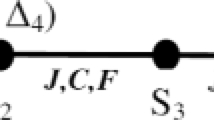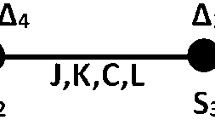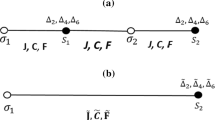Abstract
Using Monte Carlo and renormalization group methods, we investigate systems with critical behavior described by two order parameters: continuous (vector) and discrete (scalar). We consider two models of classical three-dimensional Heisenberg magnets with different numbers of spin components N = 1,…,4: the model on a cubic lattice with an additional competing antiferromagnetic exchange interaction in a layer and the model on a body-centered lattice with two competing antiferromagnetic interactions. In both models, we observe a first-order transition for all values of N. In the case where competing exchanges are approximately equal, the first order of a transition is close to the second order, and pseudoscaling behavior is observed with critical exponents differing from those of the O(N) model. In the case N = 2, the critical exponents are consistent with the well-known indices of the class of magnets with a noncollinear spin ordering. We also give a possible explanation of the observed pseudoscaling in the framework of the renormalization group analysis.
Similar content being viewed by others
References
D. Loison, “Phase transitions in frustrated vector spin systems: Numerical studies,” in: Frustrated Spin Systems (H. T. Diep, ed.), World Scientific, Singapore (2004), pp. 177–228.
B. Delamotte, D. Mouhanna, and M. Tissier, “Nonperturbative renormalization-group approach to frustrated magnets,” Phys. Rev. B, 69, 134413 (2004); arXiv:cond-mat/0309101v1 (2003).
O. A. Starykh, “Unusual ordered phases of highly frustrated magnets: A review,” Rep. Prog. Phys., 78, 052502 (2015); arXiv:1412.8482v1 [cond-mat.str-el] (2014).
H. Kawamura, “Phase transitions in Heisenberg antiferromagnets on triangular and layered-triangular lattices (invited),” J. Appl. Phys., 61, 3590–3594 (1987); “Critical properties of helical magnets and triangular antifer-romagnets,” J. Appl. Phys., 63, 3086–3088 (1988).
G. Zumbach, “Almost second order phase transitions,” Phys. Rev. Lett., 71, 2421–2424 (1993).
M. Tiesser, B. Delamotte, and D. Mouhanna, “Frustrated heisenberg magnets: A nonperturbative approach,” Phys. Rev. Lett., 84, 5208–5211 (2000); arXiv:cond-mat/0001350v1 (2000).
M. Plischke and J. Oitmaa, “Ising models with n 1: A series-expansion approach,” Phys. Rev. B, 19, 487–493 (1979).
J. R. Banavar, D. Jasnow, and D. P. Landau, “Fluctuation-induced first-order transition in a bcc Ising model with competing interactions,” Phys. Rev. B, 20, 3820–3827 (1979).
M. J. Velgakis and M. Ferer, “Fluctuation-induced, first-order transition in a bcc Ising model with competing interactions,” Phys. Rev. B, 27, 401–412 (1983).
P. Butera and M. Comi, “Critical universality and hyperscaling revisited for Ising models of general spin using extended high-temperature series,” Phys. Rev. B, 65, 144431 (2002); arXiv:hep-lat/0112049v1 (2001).
Y. Kamiya, N. Kawashima, and C. D. Batista, “Dimensional crossover in the quasi-two-dimensional Ising-O(3) model,” Phys. Rev. B, 84, 214429 (2011); arXiv:1108.1599v3 [cond-mat.str-el] (2011).
A. O. Sorokin and A. V. Syromyatnikov, “Ising–Heisenberg universality class in three-dimensional frustrated magnetic systems [in Russian],” Communication No. 2939, Petersburg Inst. Nucl. Phys., Gatchina (2013).
A. O. Sorokin, “Critical and multicritical behavior in the Ising–Heisenberg universality class,” Phys. Lett. A, 382, 3455–3462 (2018).
A. O. Sorokin, “Ising–XY transition in three-dimensional frustrated antiferromagnets with collinear spin ordering,” JETP Lett., 109, 419–423 (2019).
M. K. Ramazanov and A. K. Murtazaev, “Phase transitions and critical characteristics in the layered antiferro-magnetic Ising model with next-nearest-neighbor intralayer interactions,” JETP Lett., 101, 714–718 (2015).
A. K. Murtazaev, M. K. Ramazanov, F. A. Kassan-Ogly, and D. R. Kurbanova, “Phase transitions in the antifer-romagnetic Ising model on a body-centered cubic lattice with interactions between next-to-nearest neighbors,” JETP, 120, 110–114 (2015).
A. K. Murtazaev, M. K. Ramazanov, D. R. Kurbanova, M. K. Badiev, and Ya. K. Abuev, “A study of the critical properties of the Ising model on body-centered cubic lattice taking into account the interaction of next behind nearest neighbors,” Phys. Solid State, 59, 1103–1109 (2017).
M. K. Ramazanov and A. K. Murtazaev, “Phase transitions and critical properties in the antiferromagnetic Heisenberg model on a layered cubic lattice,” JETP Lett., 106, 86–91 (2017).
A. O. Sorokin and A. V. Syromyatnikov, “Transitions in three-dimensional magnets with extra broken symmetry,” Solid State Phenomena, 190, 63–66 (2012).
C. L. Henley, “Ordering due to disorder in a frustrated vector antiferromagnet,” Phys. Rev. Lett., 62, 2056–2059 (1989).
E. F. Shender, “Antiferromagnetic garnets with fluctuationally interacting sublattices,” Sov. Phys. JETP, 56, 178–184 (1982).
E. Brezin, J. C. Le Guillou, and J. Zinn-Justin, “Discussion of critical phenomena for general n-vector models,” Phys. Rev. B, 10, 892–900 (1974).
K. De’Bell and D. J. W. Geldart, “Coefficients to O(ε 3) for the mixed fixed point of the nm-component field model,” Phys. Rev. B, 32, 4763–4765 (1985).
Y. M. Pis’mak, A. Weber, and F. J. Wegner, “Critical behavior of a general O(n)-symmetric model of two n-vector fields in D = 4 − 2,” J. Phys. A: Math. Theor., 42, 095003 (2009); arXiv:0809.1568v2 [cond-mat.stat-mech] (2008).
P. Bak and D. Mukamel, “Physical realizations of n 4-component vector models: III. Phase transitions in Cr, Eu, MnS2, Ho, Dy, and Tb,” Phys. Rev. B, 13, 5086–5094 (1976).
S. A. Brazovskii, I. E. Dzyaloshinskii, and B. G. Kukharenko, “First-order magnetic phase transitions and fluctuations,” Sov. Phys. JETP, 43, 1178–1183 (1976).
I. E. Dzyaloshinskii, “Character of phase transitions to a helical or sinusoidal state in magnetic materials,” Sov. Phys. JETP, 45, 1014–1022 (1977).
D. R. Nelson, J. M. Kosterlitz, and M. E. Fisher, “Renormalization-group analysis of bicritical and tetracritical points,” Phys. Rev. Lett., 33, 813–817 (1974).
I. F. Lyuksyutov, V. L. Pokrovskii, and D. E. Khmel’nitskii, “Intersection of lines of second-order transitions,” Sov. Phys. JETP, 42, 923–926 (1976).
J. M. Kosterlitz, D. R. Nelson, and M. E. Fisher, “Bicritical and tetracritical points in anisotropic antiferromagnetic systems,” Phys. Rev. B, 13, 412–432 (1976).
T. Garel and P. Pfeuty, “Commensurability effects on the critical behaviour of systems with helical ordering,” J. Phys. C, 9, L245–L249 (1976).
Z. Barak and M. B. Walker, “First-order phase transitions in Tb, Dy, and Ho,” Phys. Rev. B, 25, 1969–1972 (1982).
H. Kawamura, “Renormalization-group analysis of chiral transitions,” Phys. Rev. B, 38, 4916–4928 (1988).
P. Calabrese, A. Pelissetto, and E. Vicari, “Multicritical phenomena in O(n 1) ⊕ O(n 2)-symmetric theories,” Phys. Rev. B, 67, 054505 (2003); arXiv:cond-mat/0209580v2 [cond-mat.stat-mech] (2002).
S. A. Antonenko, A. I. Sokolov, and K. B. Varnashev, “Chiral transitions in three-dimensional magnets and higher order ε expansion,” Phys. Lett. A, 208, 161–164 (1995); arXiv:cond-mat/9803377v1 [cond-mat.stat-mech] (1998).
A. Pelissetto, P. Rossi, and E. Vicari, “Large-n critical behavior of O(n) × O(m) spin models,” Nucl. Phys. B, 607, 605–634 (2001); arXiv:hep-th/0104024v2 (2001).
P. Calabrese and P. Parruccini, “Five-loop ε expansion for O(n) × O(m) spin models,” Nucl. Phys. B, 679, 568–596 (2004); arXiv:cond-mat/0308037v3 (2003).
F. R. Brown and T. J. Woch, “Overrelaxed heat-bath and Metropolis algorithms for accelerating pure gauge Monte Carlo calculations,” Phys. Rev. Lett., 58, 2394–2396 (1987).
M. Creutz, “Overrelaxation and Monte Carlo simulation,” Phys. Rev. D, 36, 515–519 (1987).
K. Binder, “Finite size scaling analysis of Ising model block distribution functions,” Z. Phys. B, 43, 119–140 (1981); “Critical properties from Monte Carlo coarse graining and renormalization,” Phys. Rev. Lett., 47, 693–696 (1981).
A. M. Ferrenberg and D. P. Landau, “Critical behavior of the three-dimensional Ising model: A high-resolution Monte Carlo study,” Phys. Rev. B, 44, 5081–5091 (1991).
H. Kawamura, “Monte Carlo study of chiral criticality–XY and Heisenberg stacked-triangular antiferromag-nets,” J. Phys. Soc. Japan, 61, 1299–1325 (1992).
A. O. Sorokin, “Critical behavior of three-dimensional frustrated helimagnets,” JETP, 118, 417–425 (2014).
A. O. Sorokin and A. V. Syromyatnikov, “First order transition in three-dimensional systems with fully broken O(3) symmetry,” JETP, 112, 1004–1012 (2011).
A. O. Sorokin and A. V. Syromyatnikov, “Transitions in three-dimensional XY magnets with two chiral order parameters,” JETP, 113, 673–677 (2011).
M. Tiesser, B. Delamotte, and D. Mouhanna, “XY frustrated systems: Continuous exponents in discontinuous phase transitions,” Phys. Rev. B, 67, 134422 (2003); arXiv:cond-mat/0107183v2 (2001).
M. L. Plumer and A. Mailhot, “Tricritical behavior of the frustrated XY antiferromagnet,” Phys. Rev. B, 50, 16113–16116 (1994); arXiv:cond-mat/9405009v1 (1994).
S. Fujimoto, “Low-energy properties of two-dimensional quantum triangular antiferromagnets: Nonperturbative renormalization group approach,” Phys. Rev. B, 73, 184401 (2006); arXiv:cond-mat/0511215v2 (2005).
N. Tetradis and C. Wetterich, “Critical exponents from the effective average action,” Nucl. Phys. B, 422, 541–592 (1994); arXiv:hep-ph/9308214v1 (1993).
Author information
Authors and Affiliations
Corresponding author
Additional information
Conflicts of Interest. The author declares no conflicts of interest.
This research is supported by the Russian Foundation for Basic Research (Grant No. 16-32-60143).
Rights and permissions
About this article
Cite this article
Sorokin, A.O. Weak First-Order Transition and Pseudoscaling Behavior in the Universality Class of the O(N) Ising Model. Theor Math Phys 200, 1193–1204 (2019). https://doi.org/10.1134/S0040577919080117
Received:
Revised:
Accepted:
Published:
Issue Date:
DOI: https://doi.org/10.1134/S0040577919080117




